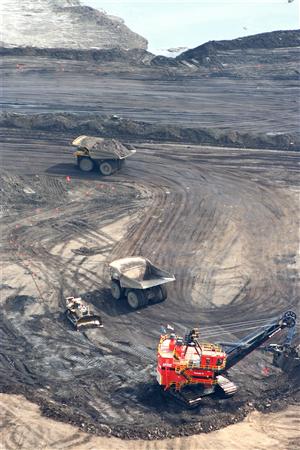Oil Sands Mining
Open-pit mining involves large-scale excavation of oil sands located near the surface. Mining is considered the “conventional” method of extracting oil sands, and today accounts for most oil sands production due to its low cost and high efficiency (ERCB 2008b).
Before mining can begin, the overburden must be removed and the site prepared. This can involve clearing trees and vegetation, removing soils and rock, draining muskeg, and redirecting streams away from the mining area. A portion of the overburden is generally stored for later use in land reclamation.
Oil sand is then scooped up from the mine by giant shovels and loaded into the world’s largest trucks—trucks with hauling capacities of up to hundreds of tonnes (ERCB 2008b). The oil sand is transported to a crusher, where it is broken up into large chunks and mixed with hot water to form a slurry. The slurry then moves through a pipeline to the project’s extraction plant in a process known as hydrotransport (OSDC 2008e). The conditioning that occurs during hydrotransport begins the process of breaking the bonds between bitumen, water, and sand, and is sometimes enhanced with the addition of caustic soda.
The slurry enters a Primary Separation Vessel (PSV), where it settles in about twenty minutes into three layers: impure bitumen froth on top, sand on the bottom, and a mixture of bitumen, sand, clay, and water (“middlings”) in the middle. The sand is pulled down from the PSV, speeding the separation, and is pumped with water into settling basins called tailings ponds. The middlings undergo secondary separation in flotation tanks. Secondary separation involves the injection of air to create additional bitumen froth, from which an additional 2 to 4% of bitumen can be recovered and redirected back to the primary system. The bitumen froth is then heated in a deaerator to remove air bubbles, and is pumped from the extraction area to the froth treatment plant (OSDC 2008e).
The bitumen froth—now consisting of bitumen, water, and solids—is diluted with naphtha and then directed through a combination of Inclined Plate Settlers (IPS) and centrifuges. These technologies separate water and solids from the bitumen using settling and centrifugal forces, leaving a clean, diluted bitumen product, nearly free from water and solids. The bitumen is then ready for upgrading into synthetic crude oil, while tailings from froth treatment are discharged to the tailings ponds after recovery of trace amounts of naphtha in a Naphtha Recovery Unit (NRU). The hot water extraction process used to isolate bitumen to this stage recovers over 91% of the bitumen in the original oil sand feed.










